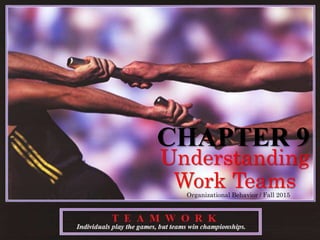
Ch 9 understanding_work_teams
- 1. CHAPTER 9 Understanding Work TeamsOrganizational Behavior / Fall 2015
- 2. WHY HAVE TEAMS BECOME SO POPULAR Teams are.. Typically outperform individuals Use employee talents better More flexible Responsive to changes in the environment Facilitate employee involvement An effective way to democratize and organization Increase motivation 9–1
- 3. TEAM VERSUS GROUP: WHAT IS THE DIFFERENCE Work Group A group that interacts primarily to share information and to make decisions to help each group member perform within his or her area of responsibility. Groups are simply the sum of individual efforts. Work Team A group whose individual efforts result in a performance that is greater than the sum of the individual inputs. Teams generate positive synergy through coordinated efforts. 9–2
- 4. COMPARING WORK GROUPS AND WORK TEAMS 9–3
- 5. 9–4
- 8. TYPES OF TEAMS Problem-Solving Teams Groups of 5 to 12 employees from the same department who meet for a few hours each week to discuss ways of improving quality, efficiency, and the work environment. Self-Managed Work Teams Groups of 10 to 15 people who take on the responsibilities of their former supervisors. 9–8
- 9. TYPES OF TEAMS (CONT’D) Cross-Functional Teams Employees from about the same hierarchical level, but from different work areas, who come together to accomplish a task. •Task forces •Committees 9–9
- 10. TYPES OF TEAMS (CONT’D) Virtual Teams Teams that use computer technology to tie together physically dispersed members in order to achieve a common goal. Team Characteristics 1. The absence of paraverbal and nonverbal cues 2. A limited social context 3. The ability to overcome time and space constraints 9–10
- 11. AN ILLUSTRATION OF VIRTUAL WORKSPACE 9–11
- 12. CREATING EFFECTIVE TEAMS: DIVERSITY Group Demography The degree to which members of a group share a common demographic attribute, such as age, sex, race, educational level, or length of service in the organization, and the impact of this attribute on turnover. Cohorts Individuals who, as part of a group, hold a common attribute. 9–12
- 13. 9–13
- 14. 9–14
- 15. 9–15
- 16. THE FIVE DYSFUNCTIONS OF A TEAM Patrick Lencioni 9–16
- 17. BREAKOUT GROUP EXERCISES Can you give some examples about dysfunctional behaviors in your work team? Do you have a dream workplace? Such as Google’s, Apple’s? Can you give some examples about advantages of your dream workplace? How many people work in your group? Do you have a leader in your group? Do you think any kind of problem exist in your group? 9–17
- 18. 9–18
- 19. TURNING INDIVIDUALS INTO TEAM PLAYERS The Challenges Overcoming individual resistance to team membership. Countering the influence of individualistic cultures. Introducing teams in an organization that has historically valued individual achievement. Shaping Team Players Selecting employees who can fulfill their team roles. Training employees to become team players. Reworking the reward system to encourage cooperative efforts while continuing to recognize individual contributions. 9–19
- 20. TEAMS AND QUALITY MANAGEMENT Team Effectiveness and Quality Management Requires That Teams: 1. Are small enough to be efficient and effective. 2. Are properly trained in required skills. 3. Allocated enough time to work on problems. 4. Are given authority to resolve problems and take corrective action. 5. Have a designated “champion” to call on when needed. 9–20
- 21. BEWARE: TEAMS AREN’T ALWAYS THE ANSWER Three tests to see if a team fits the situation: Is the work complex and is there a need for different perspectives? Does the work create a common purpose or set of goals for the group that is larger than the aggregate of the goals for individuals? Are members of the group involved in interdependent tasks? 9–21
- 22. 12 STEPS TO MORE EFFICIENT AND EFFECTIVE MEETINGS:1. Prepare a meeting agenda. 2. Distribute the agenda in advance. 3. Consult with participants before the meeting. 4. Get participants to go over the agenda. 5. Establish specific time parameters. 6. Maintain focused discussion. 7. Encourage and support participation of all members. 8. Maintain a balanced style. 9. Encourage the clash of ideas. 10. Discourage the clash of personalities. 11. Be an effective listener. 12. Bring proper closure. 9–22
- 23. VIDEOS 9–23 Japanese Students https://www.youtube.com/watch?v=s-poQaPPJbQ Madagascar Penguins https://www.youtube.com/watch?v=DI4zp7yeuMU Construction in Nepal https://www.youtube.com/watch?v=mctUNUQSJCo Northwestern Football Team Building Exercise https://www.youtube.com/watch?v=mOo1hKTSdtM Teamwork https://www.youtube.com/watch?v=nyendnJTJmQ Football Teamwork https://www.youtube.com/watch?v=crTszPZAVLM